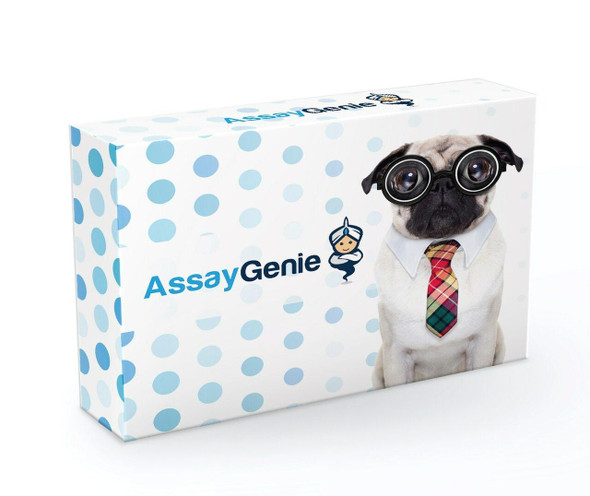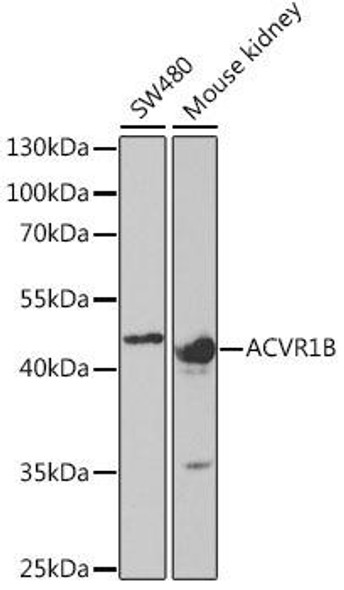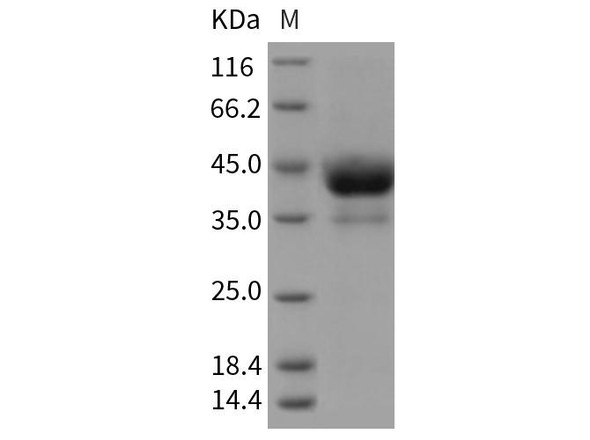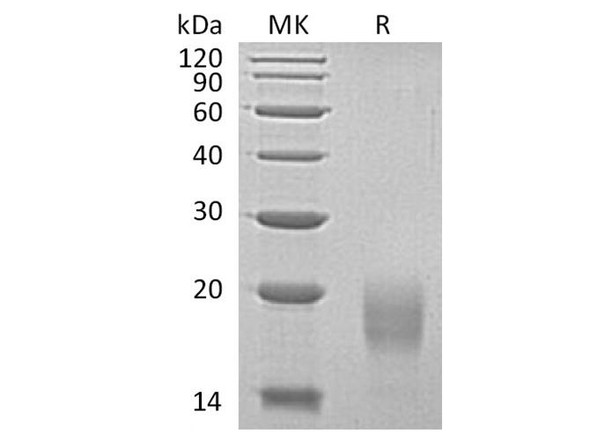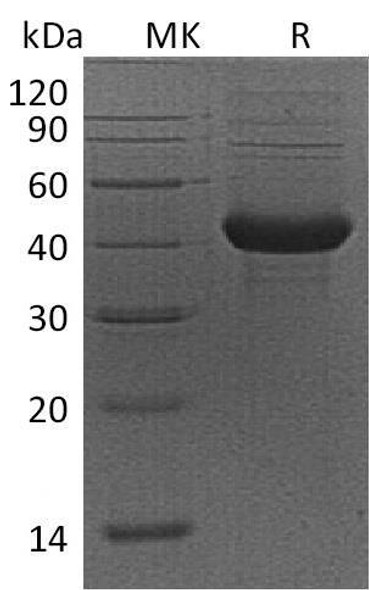Description
| Product Name: | ACVR1B Rabbit mAb |
| Product Code: | CAB2279 |
| Size: | 20uL, 50uL, 100uL |
| Synonyms: | ACTRIB, ACVRLK4, ALK4, SKR2 |
| Applications: | WB, IHC, IF |
| Reactivity: | Human, Mouse, Rat |
| Host Species: | Rabbit |
| Immunogen: | A synthesized peptide derived from human ACVR1B |
| Applications: | WB, IHC, IF |
| Recommended Dilutions: | WB 1:500 - 1:2000 IHC 1:50 - 1:200 IF 1:50 - 1:200 |
| Reactivity: | Human, Mouse, Rat |
| Positive Samples: | 293T, HepG2, U-87MG, Mouse brain, Rat brain |
| Immunogen: | A synthesized peptide derived from human ACVR1B |
| Purification Method: | Affinity purification |
| Storage: | Store at -20°C. Avoid freeze / thaw cycles. Buffer: PBS with 0.02% sodium azide, 0.05% BSA, 50% glycerol, pH7.3. |
| Isotype: | IgG |
| Sequence: | Email for sequence |
| Gene ID: | 91 |
| Uniprot: | P36896 |
| Calculated MW: | 52kDa |
| Observed MW: | 52kDa |
| UniProt Protein Function: | ALK4: Transmembrane serine/threonine kinase activin type-1 receptor forming an activin receptor complex with activin receptor type-2 (ACVR2A or ACVR2B). Transduces the activin signal from the cell surface to the cytoplasm and is thus regulating a many physiological and pathological processes including neuronal differentiation and neuronal survival, hair follicle development and cycling, FSH production by the pituitary gland, wound healing, extracellular matrix production, immunosuppression and carcinogenesis. Activin is also thought to have a paracrine or autocrine role in follicular development in the ovary. Within the receptor complex, type-2 receptors (ACVR2A and/or ACVR2B) act as a primary activin receptors whereas the type-1 receptors like ACVR1B act as downstream transducers of activin signals. Activin binds to type-2 receptor at the plasma membrane and activates its serine- threonine kinase. The activated receptor type-2 then phosphorylates and activates the type-1 receptor such as ACVR1B. Once activated, the type-1 receptor binds and phosphorylates the SMAD proteins SMAD2 and SMAD3, on serine residues of the C- terminal tail. Soon after their association with the activin receptor and subsequent phosphorylation, SMAD2 and SMAD3 are released into the cytoplasm where they interact with the common partner SMAD4. This SMAD complex translocates into the nucleus where it mediates activin-induced transcription. Inhibitory SMAD7, which is recruited to ACVR1B through FKBP1A, can prevent the association of SMAD2 and SMAD3 with the activin receptor complex, thereby blocking the activin signal. Activin signal transduction is also antagonized by the binding to the receptor of inhibin-B via the IGSF1 inhibin coreceptor. ACVR1B also phosphorylates TDP2. ACVRIB is abundantly expressed in systemic sclerosis patient fibroblasts and production of collagen is also induced by activin-A/INHBA. This suggests that the activin/ACRV1B signaling mechanism is involved in systemic sclerosis. Belongs to the protein kinase superfamily. TKL Ser/Thr protein kinase family. TGFB receptor subfamily. 5 isoforms of the human protein are produced by alternative splicing. |
| UniProt Protein Details: | Protein type:Protein kinase, TKL; Kinase, protein; EC 2.7.11.30; Membrane protein, integral; Protein kinase, Ser/Thr (receptor); TKL group; STKR family; Type1 subfamily Chromosomal Location of Human Ortholog: 12q13 Cellular Component: cell surface; integral to plasma membrane; plasma membrane; activin receptor complex; receptor complex Molecular Function:activin receptor activity; metal ion binding; transmembrane receptor protein serine/threonine kinase activity; transforming growth factor beta receptor activity; protein serine/threonine kinase activity; protein binding; activin receptor activity, type I; growth factor binding; ubiquitin protein ligase binding; activin binding; SMAD binding; ATP binding; receptor signaling protein serine/threonine kinase activity Biological Process: development of primary female sexual characteristics; central nervous system development; in utero embryonic development; protein amino acid autophosphorylation; positive regulation of erythrocyte differentiation; activin receptor signaling pathway; peptidyl-threonine phosphorylation; signal transduction; protein amino acid phosphorylation; positive regulation of activin receptor signaling pathway; hair follicle development; regulation of transcription, DNA-dependent; transmembrane receptor protein serine/threonine kinase signaling pathway; positive regulation of transcription from RNA polymerase II promoter; negative regulation of cell growth; G1/S transition of mitotic cell cycle |
| NCBI Summary: | This gene encodes an activin A type IB receptor. Activins are dimeric growth and differentiation factors which belong to the transforming growth factor-beta (TGF-beta) superfamily of structurally related signaling proteins. Activins signal through a heteromeric complex of receptor serine kinases which include at least two type I and two type II receptors. This protein is a type I receptor which is essential for signaling. Mutations in this gene are associated with pituitary tumors. Alternate splicing results in multiple transcript variants.[provided by RefSeq, Jun 2010] |
| UniProt Code: | P36896 |
| NCBI GenInfo Identifier: | 547775 |
| NCBI Gene ID: | 91 |
| NCBI Accession: | P36896.1 |
| UniProt Secondary Accession: | P36896,Q15479, Q15480, Q15481, Q15482, B7Z5L8, B7Z5W5 |
| UniProt Related Accession: | P36896 |
| Molecular Weight: | 51,725 Da |
| NCBI Full Name: | Activin receptor type-1B |
| NCBI Synonym Full Names: | activin A receptor, type IB |
| NCBI Official Symbol: | ACVR1B |
| NCBI Official Synonym Symbols: | ALK4; SKR2; ACTRIB; ACVRLK4 |
| NCBI Protein Information: | activin receptor type-1B; activin receptor-like kinase 4; activin A receptor, type II-like kinase 4; serine/threonine-protein kinase receptor R2 |
| UniProt Protein Name: | Activin receptor type-1B |
| UniProt Synonym Protein Names: | Activin receptor type IB; ACTR-IB; Activin receptor-like kinase 4; ALK-4; Serine/threonine-protein kinase receptor R2; SKR2 |
| Protein Family: | Activin receptor |
| UniProt Gene Name: | ACVR1B |
| UniProt Entry Name: | ACV1B_HUMAN |


